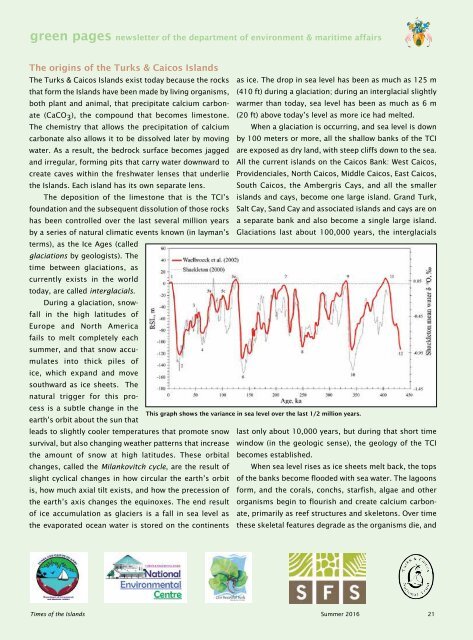Times of the Islands Summer 2016
Presents the "soul of the Turks & Caicos Islands" with in-depth features about local people, culture, history, environment, businesses, resorts, restaurants and activities.
Presents the "soul of the Turks & Caicos Islands" with in-depth features about local people, culture, history, environment, businesses, resorts, restaurants and activities.
Create successful ePaper yourself
Turn your PDF publications into a flip-book with our unique Google optimized e-Paper software.
green pages newsletter <strong>of</strong> <strong>the</strong> department <strong>of</strong> environment & maritime affairs<br />
The origins <strong>of</strong> <strong>the</strong> Turks & Caicos <strong>Islands</strong><br />
The Turks & Caicos <strong>Islands</strong> exist today because <strong>the</strong> rocks as ice. The drop in sea level has been as much as 125 m<br />
that form <strong>the</strong> <strong>Islands</strong> have been made by living organisms, (410 ft) during a glaciation; during an interglacial slightly<br />
both plant and animal, that precipitate calcium carbonate<br />
(CaCO 3 ), <strong>the</strong> compound that becomes limestone. (20 ft) above today’s level as more ice had melted.<br />
warmer than today, sea level has been as much as 6 m<br />
The chemistry that allows <strong>the</strong> precipitation <strong>of</strong> calcium When a glaciation is occurring, and sea level is down<br />
carbonate also allows it to be dissolved later by moving by 100 meters or more, all <strong>the</strong> shallow banks <strong>of</strong> <strong>the</strong> TCI<br />
water. As a result, <strong>the</strong> bedrock surface becomes jagged are exposed as dry land, with steep cliffs down to <strong>the</strong> sea.<br />
and irregular, forming pits that carry water downward to All <strong>the</strong> current islands on <strong>the</strong> Caicos Bank: West Caicos,<br />
create caves within <strong>the</strong> freshwater lenses that underlie Providenciales, North Caicos, Middle Caicos, East Caicos,<br />
<strong>the</strong> <strong>Islands</strong>. Each island has its own separate lens. South Caicos, <strong>the</strong> Ambergris Cays, and all <strong>the</strong> smaller<br />
The deposition <strong>of</strong> <strong>the</strong> limestone that is <strong>the</strong> TCI’s islands and cays, become one large island. Grand Turk,<br />
foundation and <strong>the</strong> subsequent dissolution <strong>of</strong> those rocks Salt Cay, Sand Cay and associated islands and cays are on<br />
has been controlled over <strong>the</strong> last several million years a separate bank and also become a single large island.<br />
by a series <strong>of</strong> natural climatic events known (in layman’s Glaciations last about 100,000 years, <strong>the</strong> interglacials<br />
terms), as <strong>the</strong> Ice Ages (called<br />
glaciations by geologists). The<br />
time between glaciations, as<br />
currently exists in <strong>the</strong> world<br />
today, are called interglacials.<br />
During a glaciation, snowfall<br />
in <strong>the</strong> high latitudes <strong>of</strong><br />
Europe and North America<br />
fails to melt completely each<br />
summer, and that snow accumulates<br />
into thick piles <strong>of</strong><br />
ice, which expand and move<br />
southward as ice sheets. The<br />
natural trigger for this process<br />
is a subtle change in <strong>the</strong><br />
This graph shows <strong>the</strong> variance in sea level over <strong>the</strong> last 1/2 million years.<br />
earth’s orbit about <strong>the</strong> sun that<br />
leads to slightly cooler temperatures that promote snow last only about 10,000 years, but during that short time<br />
survival, but also changing wea<strong>the</strong>r patterns that increase window (in <strong>the</strong> geologic sense), <strong>the</strong> geology <strong>of</strong> <strong>the</strong> TCI<br />
<strong>the</strong> amount <strong>of</strong> snow at high latitudes. These orbital becomes established.<br />
changes, called <strong>the</strong> Milankovitch cycle, are <strong>the</strong> result <strong>of</strong> When sea level rises as ice sheets melt back, <strong>the</strong> tops<br />
slight cyclical changes in how circular <strong>the</strong> earth’s orbit <strong>of</strong> <strong>the</strong> banks become flooded with sea water. The lagoons<br />
is, how much axial tilt exists, and how <strong>the</strong> precession <strong>of</strong> form, and <strong>the</strong> corals, conchs, starfish, algae and o<strong>the</strong>r<br />
<strong>the</strong> earth’s axis changes <strong>the</strong> equinoxes. The end result organisms begin to flourish and create calcium carbonate,<br />
primarily as reef structures and skeletons. Over time<br />
<strong>of</strong> ice accumulation as glaciers is a fall in sea level as<br />
<strong>the</strong> evaporated ocean water is stored on <strong>the</strong> continents <strong>the</strong>se skeletal features degrade as <strong>the</strong> organisms die, and<br />
<strong>Times</strong> <strong>of</strong> <strong>the</strong> <strong>Islands</strong> <strong>Summer</strong> <strong>2016</strong> 21

















